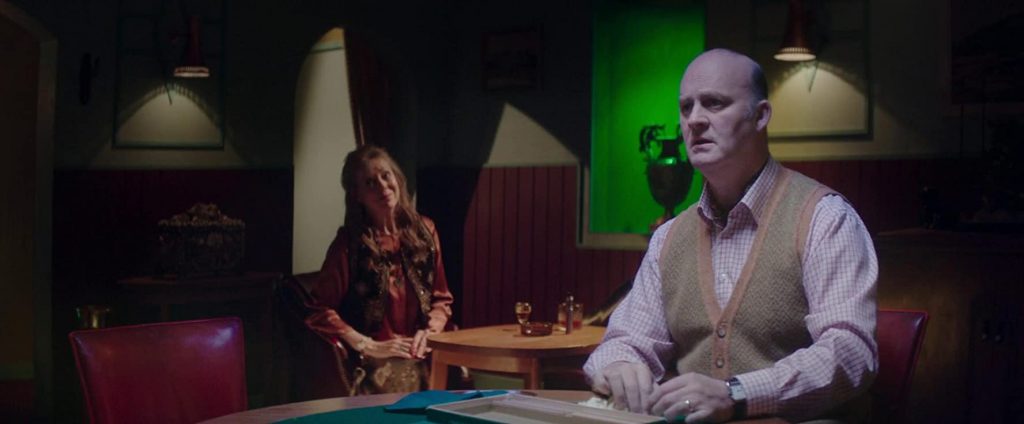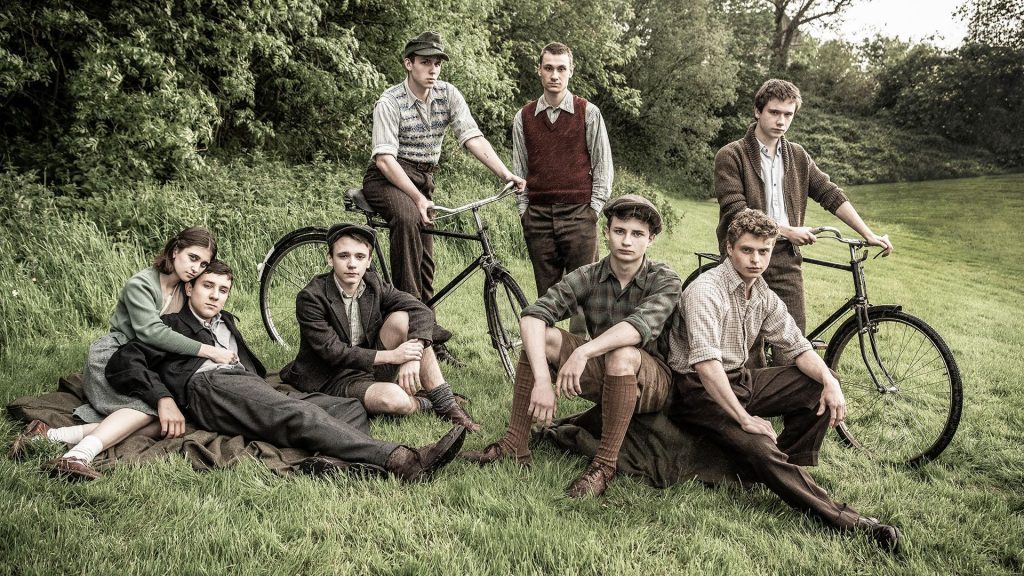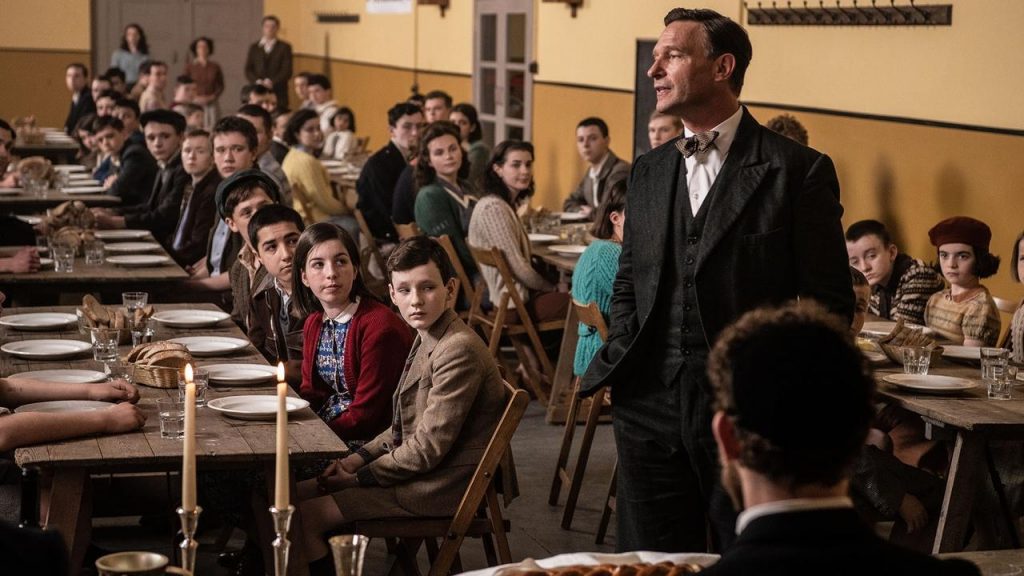June 15, 2020
by Carla Hay

Directed by Carl Hunter
Culture Representation: Taking place in unnamed cities in England, the comedy drama “Sometimes Always Never” has almost all white cast (with one biracial/black character) representing the middle-class.
Culture Clash: A tailor and his adult son have emotional tensions with each other, stemming from the childhood disappearance of the tailor’s other son.
Culture Audience: “Sometimes Always Never” will appeal primarily to people who are fans of Bill Nighy and dry British humor.

Bill Nighy tends to play a lot of characters with a droll sense of humor, so the dark comedy/drama “Sometimes Always Never” is right up his alley. This quirky film, which takes place in suburban England, won’t appeal to everyone, but viewers who enjoy “Sometimes Always Never” will probably like the film more for the actors’ performances than for the movie’s somewhat thin plot.
Directed by Carl Hunter and written by Frank Cottrell Boyce, “Sometimes Always Never” focuses mainly on the tension-filled relationship between a widowed tailor named Alan Mellor (played by Nighy) and his son Peter (played by Sam Riley), who can’t go a day together without bickering with each other. The reason they don’t seem to particularly get along is because years ago, when Peter was a boy, his brother Michael disappeared after storming out of their home during an argument while Michael was playing Scrabble with Peter and Alan. Michael has remained missing all these years later.
The mystery of Michael’s disappearance has affected both men in different ways, even though they both have similar unspoken resentment and guilt over the disappearance. Alan thinks Michael might still be alive, while Peter is convinced that Michael is probably dead.
Alan has become obsessed with Scrabble and finds any way he can to conjure up theories that he can somehow find Michael again by playing Scrabble. He plays Scrabble online and tells Peter about on online rapport he’s developed with a Scrabble gamer who goes by the name Skinny Thesaurus. Peter says he hates Scrabble and expresses his distaste over Alan’s far-fetched theories and continued obsession with this word game.
Alan is so stuck in the past over Michael’s disappearance that he still hands out a missing-person photo of Michael to strangers, even though the photo is of Michael as a child. It’s one of the first things that viewers see Alan doing in the movie’s opening scene, which takes place at an almost deserted beach.
Peter meets Alan at the beach to pick him up in his car, so they can go on a solemn journey together. The reason for this out-of-town trip? A body has been found that could be Michael. Alan and Peter have to travel to the morgue to identify the body.
During the trip, the father and son trade verbal barbs at each other, including their ongoing debates about synonyms and what words can legitimately be used in a Scrabble game. Peter is impatient about this trip and tells Alan that he’s got to go back as soon as possible to his wife, Sue (played by Alice Lowe), who’s a chemical scientist. Alan says to Peter, “I’m sure I’m going deaf. I don’t hear half of what you say.”
When Alan and Peter check into their hotel, the bickering continues. In the hotel lounge, they meet a married couple named Arthur (played by Tim McInnerny) and Margaret (played by Jenny Agutter) and make some small talk. The conversation inevitably turns to Scrabble, and it isn’t long before Alan, Margaret and Arthur start playing Scrabble together in the lounge, while Peter has left to go to his hotel room.
While Arthur takes a restroom break, Margaret confides in Alan that her husband used to be a singer who would record albums of cover songs for record companies looking to cash in on hits that were popular at the time. One of the cover songs he recorded is Bonnie Tyler’s “It’s a Heartache,” which is heard later in the story. Margaret also tells Alan that the reason why she and Arthur are in town is because they have to identify the body of their son who went missing when he was a child.
During the Scrabble game, Alan doesn’t tell Margaret and Arthur that he’s in town for the same reason. Arthur and Margaret find out the next day when they see Alan and Peter at the morgue at the same time. (It’s revealed in the movie if the child at the morgue is from either family.)
Peter gets very upset when he finds out that Alan was a fierce competitor with Arthur during the Scrabble game, and Alan ended up winning £200 from Arthur. Peter offers to pay back the money to Arthur and Margaret, but they politely decline. Peter scolds Alan for taking advantage of the couple, knowing that they are going through the same trauma of identifying the body. Alan just shrugs and says that he couldn’t help himself.
During the trip, Alan stays with Peter and his family, which includes Peter and Susie’s teenage son Jack (played by Louis Healy), a loner who spends most of his free time playing online video games. When Alan tells Peter that he’s concerned about Jack spending so much time on the computer, Peter replies: “Why would that be a worry? He’s at home. He’s not on the streets. He hasn’t gone missing.” Ouch.
As the story unfolds, there are other things that Peter brings up from the past when he argues with Alan. Peter hated that Alan had a habit of giving Peter cheap toys and games that were knock-offs of the originals. And because Peter’s mother died when he was a child (it isn’t specified when she passed away), Peter still feels resentment that he was raised by a father who focused a lot of energy on finding Michael.
There’s a minor subplot of the dynamics between Jack and his adult relatives. Jack and Alan form somewhat of a kinship when Alan becomes fascinated with Jack’s online computer games. Meanwhile, Sue has a habit of embarrassing Jack at bus stops, where he meticulously plans to be at the same time as a teenage girl named Rachel (played by Ella-Grace Gregoire), whom Jack has had a crush on for a while.
As for the movie’s title of “Sometimes Always Never,” that comes from a scene in the film where Alan is showing Jack some tailoring tips for suits. Alan tells Jack that when it comes to a suit jacket’s first three buttons, the first one should “sometimes” be buttoned, the second one should “always” be button, and the third should “never” be buttoned.
Alan has his own tailor shop (called Mellors Tailors) but the movie shows him doing very little work in his chosen profession. There’s that grandfather-grandson scene with Alan and Jack. And there’s another scene where Alan is shown alone at the shop, as if business is slow. Alan’s line of work actually isn’t that necessary for the plot, and the only real purpose is seemingly because the button advice he gave Jack ended up being used as the movie’s title.
There’s a scene in the movie where Alan, Sue, Jack and Rachel are playing a Scrabble board game together. Peter is watching nearby. Alan questions Sue’s use of a scientific word, while Peter tells Alan not to question his wife’s scientific knowledge. Alan persists anyway and looks up the validity of the word in a dictionary. Peter explodes with anger.
It’s clear that what Peter is angry about is really not about Alan questioning Sue’s word knowledge but about feeling like an outsider in his own household. And perhaps there’s some jealousy that Alan is forming a closer bond to Jack than Peter even had with Alan. And things get even more tense when Alan becomes convinced that an anonymous online Scrabble gamer is really the missing Michael who’s sending clues about his whereabouts.
“Sometimes Always Never” frequently uses a technique of having a particular word and its definition shown before each of the movie’s three acts. The movie has the look and feel of a stage play, not just because there’s a small number of people in the cast but also because of the lo-fi production design by Tim Dickel and art direction by Guto Humphreys. (The driving scenes in the car were obviously done in front of a green or blue screen.)
The visual look of the movie (from cinematographer Richard Stoddard) is kind modern yet retro, with copious use of low lighting for the interior scenes. Almost all of the buildings in the film have interior walls painted green, blue and red. These bright colors for walls in houses or a hotel are not very common for suburban England. It seems as if the filmmakers wanted to give the impression that this is a more whimsical England, compared to what’s normally seen in movies.
Although the acting from Nighy and Riley is very good, and the movie does a convincing flipping of traditional parent-child roles (Alan is impulsive and slightly rebellious, while Peter is more cautious and scolding), “Sometimes Always Never” has pacing that’s a little too sluggish at times. People will enjoy this movie best if they’ve got about 90 minutes to spare and aren’t expecting a lot of fast-paced action, loads of suspense or obvious jokes.
Blue Fox Entertainment released “Sometimes Always Never” in select U.S. virtual cinemas on June 12, 2020. The film’s U.S. digital and VOD release is on July 10, 2020. “Sometimes Always Never” was originally released in the United Kingdom and several other countries in 2019.


